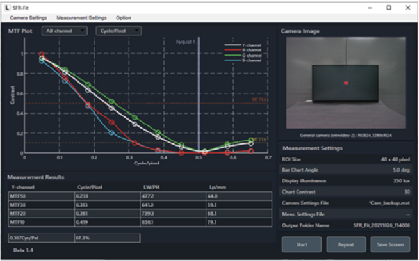Search Results for: MTF
Test chart suitability for MTF measurements
Related pages: Compensating camera MTF measurements for chart and sensor MTF – Introduction – Calculation – MTF compensation files – Applying the compensation – Lens MTF measurements Chart Quality Calculator – determine the suitability of a chart (based on MTF measurements for specific media & print methods) for a specific application Sharpness assumption | Chart suitability display | Using the figure Inkjet matte | B&W photo paper | Color LVT | B&W LVT | MTF suitability calculations Whenever a test chart is used to measure camera MTF (sharpness)— and that includes a large portion of Imatest measurements— we need to know if the chart is good enough to reliably measure MTF. “Good enough” means that chart […]
Slanted-edge MTF measurement consistency
Note: This page is not quite complete, but we felt that the results are important enough to be presented in its present (nearly complete) state. Method – Results – MTF50 failure – MTF Area Related page: Correcting Misleading Image Quality Measurements: links to an Electronic Imaging paper that compares MTF summary metrics In this page we analyze the consistency of slanted-edge MTF measurements, focusing on the effects of noise and region size on measurement consistency. We describe the test procedure in sufficient detail to enable Imatest users to perform similar studies for themselves. We also discuss some important and recognizable situations where […]
SFR results: Edge and MTF (Sharpness) plot
A key result of the SFR, SFRplus, and eSFR ISO modules If you entered Imatest on this page, you may want to explore the background information in these links. Sharpness introduces sharpness measurements and MTF. How to test Lenses with Imatest contains concise instructions on testing lenses using SFRplus and eSFR ISO. Image quality factors lists the factors measured by Imatest. Table of contents (documentation) Imatest SFR, SFRplus and eSFR ISO display Edge profiles and SFR (Spatial frequency response, i.e., MTF) plots with spatial frequency labeled in one of the following units: Cycles per […]
MTF Compare
Compare MTFs of individual edge regions in different cameras and lenses Introduction to MTF Compare MTF Compare (not included in Imatest Studio), is a post-processor for comparing the MTFs of different cameras, lenses, and imaging systems that have been analyzed by SFR, Rescharts Slanted-edge SFR, SFRplus, or eSFR ISO, and had results saved in CSV files. Comparisons are displayed as quotients of MTFs, i.e., transfer functions. For two imaging systems A and B, MTF Compare plots MTF(A)/MTF(B) or MTF(B)/MTF(A) along with MTF(A) and MTB(B) (shown as faint lines below). Details depend on the Display setting. Displays ratios or values of […]
Compensating camera MTF measurements for chart and sensor MTF
Summary MTF measurements can be compensated for measured chart quality. Chart MTF compensation can double the megapixel suitability of a test chart. Results taken with different test charts will be more consistent. An approximate lens MTF calculation (independent of chart MTF compensation) has been added. It is based on a geometrical model of sensor MTF, which is used because reliable sensor MTF measurements are difficult to obtain. It’s not perfect, but it is good enough for many measurements. A Chart Quality Calculator lets you determine the suitability of a test chart (based on the camera’s Vertical Field of View, vertical […]
Leader SFR-Fit MTF Measurement Software
Software for measuring the spatial frequency response (SFR) of cameras
SFR-Fit is camera resolution measurement software that measures MTF (Modulation Transfer Function). MTF indicates spatial frequency characteristics using multiple distortion and uniformity-corrected sine patterns that can be presented across one or more displays.
Conventional MTF measurement methods can have issues with black box camera systems that prevent the acquisition of the RAW or minimally processed image. If these systems have sharpening enabled, slanted edges can overstate MTF, especially at high frequencies.
The SFR-Fit measurement system can produce highly accurate measurements of automotive cameras and is compatible with ultra-wide-angle lenses.
Annual subscription license
Displays used as test targets are to be purchased separately. A matte surface display and at least 3x higher display pixel density vs camera resolution are suggested.
Click here for a guide on selecting displays.
Click here for a calibrated reference camera for testing Camera Monitor Systems (CMS)
Interpolated slanted-edge SFR (MTF) calculation
Introduction – The problem and its solution – working with the interpolated algorithm – Identifying the problem – Image comparisons – Algorithm – SFRMAT5 – Extreme noise – Motion blur – Summary Introduction Note: MTF (Modulation Transfer Function) and SFR (Spatial Frequency Response) are (almost) synonymous. Older papers mostly use MTF, but the current practice (for example in recent versions of the ISO 12233 standard) prefers SFR. In the process of developing the image information metric calculations, we observed an inconsistency in the Noise Equivalent Quanta (NEQ) calculations, which should be unaffected by image processing as long as it is linear […]
MTF curves and Image appearance
Correlating measurement with appearance Modulation Transfer Function (MTF) is a fundamental measure of imaging system sharpness. It is introduced in Sharpness and discussed further in Sharpening. MTF is measured by Imatest SFR, SFRplus, and by several Rescharts modules. The most frequent questions that arise in sharpness (MTF) testing are “What does the MTF curve mean?” and “How does MTF correlate with image appearance?” In this page we attempt to answer these questions through examples that let you quickly compare images with corresponding MTF curves by clicking on Quick links to the left of each each edge image. Introduction The procedure […]


